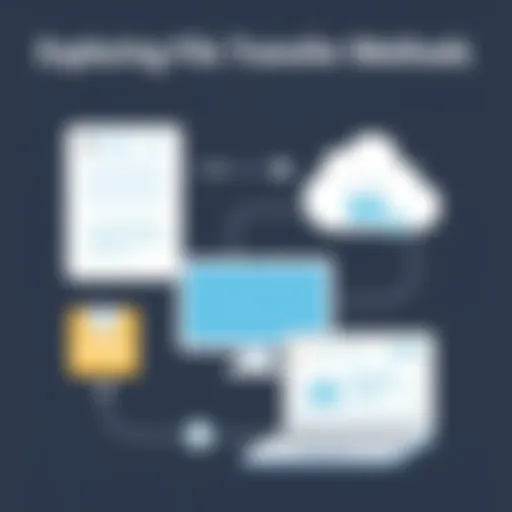Exploring the Benefits of Free Bus Routing Software


Intro
The evolution of public transportation systems has increased the demand for efficient routing solutions. Free bus routing software has emerged as a pivotal tool in this landscape. Its core purpose is to optimize routes, reduce operational costs, and improve service delivery to passengers. Understanding how this software works and what it offers is essential for decision-makers, IT professionals, and entrepreneurs.
Industry Overview
The bus routing software industry is currently undergoing significant transformations. With the rise of smart cities, there is a strong focus on integrating technology into public transport systems. Current trends reflect a shift towards data-driven decision-making. As cities grow, the complexity of routes increases, necessitating sophisticated software solutions.
Key Trends in the Industry:
- Real-time data analytics: This involves leveraging data for on-the-go adjustments in routes based on traffic conditions and passenger demand.
- User-friendly interfaces: The emphasis is on making software accessible for all levels of users, which boosts adoption and usage.
- Sustainability and efficiency: There is a growing need to minimize carbon footprints and maximize fuel efficiency.
Nevertheless, buyers face challenges when selecting software. The market is vast, and the options can be overwhelming. Often, businesses struggle to identify their specific needs amid a sea of features.
Top Software Options
While there are many providers of bus routing software, some have established themselves as leaders. These options typically stand out due to their functionalities, user experience, and overall market presence.
Notable Software Providers:
- OpenTripPlanner
- RouteXL
- OptimoRoute
When comparing software solutions, it is crucial to consider the following features:
- Route optimization capabilities
- Integrations with other transport systems
- User support and training resources
Pricing Structures can vary widely. Some offer free versions with limited features, while others may charge a monthly or annual fee. Understanding the cost-benefit ratio is vital for making the right choice.
Selection Criteria
Selecting the appropriate bus routing software involves various important factors:
- Compatibility with current systems: Ensure it can work with existing tools and platforms.
- Scalability: Opt for solutions that can grow alongside your operations.
- User feedback: Look for software with positive reviews from current users.
Avoid common mistakes like focusing solely on price without considering functionality, or neglecting to involve users in the selection process. Involving stakeholders ensures the software aligns with real-world requirements.
Implementation Strategies
The implementation of new software can pose challenges. Best practices for a smooth transition include:
- Clear planning: Define roles, timelines, and expectations upfront.
- Pilot testing: Run a small-scale trial to identify potential issues before full deployment.
- Training sessions: Provide comprehensive support for users to foster confidence in the new system.
Future Trends
Looking ahead, the bus routing software industry will likely see further advancements. Emerging technologies such as artificial intelligence and machine learning will play a significant role in shaping the future. Predictive analytics could provide tools for anticipating demand and optimizing routes even before the need arises.
Recommendations for future-proofing include:
- Investing in adaptable technology that can evolve with the industry.
- Staying informed about trends and updates in technology to maintain a competitive edge.
The right software can significantly impact the efficiency of transportation systems, making an informed decision essential.
Understanding free bus routing software is not merely about recognizing its functionalities, but also about grasping its implications for operational efficiency. Each choice made impacts not only organizations but also the communities they serve.
Prologue to Bus Routing Software
Bus routing software plays a crucial role in today’s transportation management landscape. As cities expand and public transport systems grow more complex, the demands on bus services increase. Efficiently routing buses can greatly influence operational costs, timeliness, and rider satisfaction. Therefore, understanding how bus routing software operates is essential for decision-makers and IT professionals.
Definition of Bus Routing Software
Bus routing software refers to specialized computer applications designed to aid organizations in managing their bus transit systems. These systems optimize routes, manage schedules, and streamline operations for bus services. The primary goal is to ensure that buses reach their destinations in a timely fashion while minimizing operational expenditures. They achieve this by analyzing various factors, such as passenger demand, traffic conditions, and historical performance data.
Importance in Transportation Management
The significance of bus routing software in transportation management cannot be overstated. The software provides numerous benefits:
- Resource Optimization: By effectively planning routes, organizations can reduce fuel consumption and labor costs.
- Enhanced Service Reliability: Well-optimized routes and schedules lead to improved service frequency and reduced waiting times for passengers.
- Improved Data Management: These systems gather valuable data on route performance, helping managers to make informed decisions.
Moreover, bus routing software not only affects businesses economically but also impacts social factors. A reliable bus system can encourage more individuals to use public transport, thus alleviating traffic congestion and lowering emissions. This point exemplifies why investment in sophisticated routing software is vital.
In sum, knowledge of bus routing software is a foundational element for improving transportation management, maximizing efficiency and meeting the growing demands of urban mobility.
Overview of Free Software Options
Free bus routing software plays a pivotal role in enhancing operational efficiency within transportation systems. In this section, we will explore what constitutes free software options in bus routing and how these choices reflect on an organization’s strategic decisions. The relevance of understanding these options cannot be overstated, especially for decision-makers who aim to optimize their transit operations without incurring significant costs.
Characteristics of Free Software
Free bus routing software typically boasts several defining characteristics. First, these tools are generally accessible at no cost, allowing organizations with limited budgets to invest in technology that improves service delivery.
Notably, many free solutions often offer a diverse range of functionalities, including route optimization and real-time tracking. However, these tools may come with certain limitations, such as reduced technical support or incomplete features. Organizations need to evaluate whether these characteristics align with their operational requirements.
Here are some common features of free software:


- User-Friendly Interface: A simple design can facilitate easy navigation for all users.
- Basic Route Planning: This includes simple route creation and modification tools.
- Community Support: Many free solutions rely on user communities for support rather than formal assistance.
Comparing Free vs. Paid Solutions
When comparing free options to paid bus routing software, several key differences emerge. Paid solutions usually provide a broader array of features and enhanced technical support, which can be critical for larger organizations or complex routing needs. These solutions often include advanced functionalities like data analytics and performance reporting.
In contrast, free options may be adequate for smaller operations or those just starting. However, as a business grows, it may encounter challenges with scalability and integration capabilities. This can necessitate a shift toward more robust paid solutions.
Key points in this comparison include:
- Cost: Free tools are budget-friendly but may require more manual processes.
- Feature Set: Paid software often offers more comprehensive functionalities.
- Technical Support: Paid solutions typically have dedicated support teams for assistance.
- Updates and Maintenance: Paid options frequently offer regular updates, enhancing security and performance.
In many cases, the decision between free and paid software ultimately hinges on the specific needs of the organization and the complexity of its operations.
The landscape of software options for bus routing is extensive. By thoroughly assessing free options, organizations can make informed decisions that match their operational needs. The correct choice can lead to improved productivity while remaining within budget limitations.
Functionalities of Free Bus Routing Software
Understanding the functionalities of free bus routing software is essential for organizations aiming to optimize their transportation networks. This section explores key capabilities that these tools offer, including route optimization, real-time tracking, and data analytics. Each functionality addresses specific pain points faced by transportation management, making them invaluable for operators seeking efficiency and cost-effectiveness.
Route Optimization
Route optimization is a core functionality that significantly enhances the efficiency of transportation systems. It involves using algorithms to calculate the best possible routes for buses. The main benefit is reducing travel time and fuel consumption, leading to lower operational costs.
Free bus routing software often employs advanced techniques, such as geographic information systems and machine learning, to analyze various variables, such as traffic patterns and passenger loads. This allows for dynamic adjustments to routes based on real-time conditions.
Organizations must consider the specific needs of their operation when evaluating route optimization tools. Some software options may offer basic functionality, while others provide more complex algorithms that can handle diverse scenarios.
Real-Time Tracking
Real-time tracking is another critical feature that allows operators to monitor bus locations continuously. This functionality enhances service reliability and improves passenger experience by providing accurate arrival times.
With free software solutions, tracking systems often utilize GPS technology to provide live updates. Passengers can access this information through mobile applications or digital displays at stations. Being informed about bus movements can greatly reduce waiting times and improve overall satisfaction.
For management, real-time tracking enables better decision-making. By analyzing where delays are occurring, managers can quickly implement strategies to react, such as rerouting buses or adjusting schedules. However, it is important to ensure that the software integrates seamlessly with existing fleet management systems to maximize its utility.
Data Analytics Capabilities
Data analytics capabilities in free bus routing software provide insights into operational efficiency and passenger behavior. By collecting and analyzing data from various sources, organizations can make informed decisions to enhance their services.
This includes understanding peak travel times, identifying under-utilized routes, and evaluating operational costs. Free software often includes basic reporting tools but may lack the depth found in paid alternatives. Therefore, decision-makers should assess whether the analytics offered meet their specific needs.
Furthermore, organizations must consider data privacy and compliance with regulations when implementing analytics tools. Protecting passenger data while utilizing it for service improvement is crucial.
Advantages of Using Free Bus Routing Software
The adoption of free bus routing software provides several key advantages worth exploring. These benefits can significantly enhance the operational efficiency of transportation systems. Understanding these advantages allows decision-makers and IT professionals to carefully evaluate their choices before implementation.
Cost Efficiency
One primary benefit of using free bus routing software is cost efficiency. Unlike paid alternatives, which can require substantial financial investment, free options eliminate license fees and can significantly reduce overall expenses. For organizations, especially smaller transit operators or startups, this means that they can allocate more funds to other critical areas such as vehicle maintenance or driver training.
Additionally, free software often comes with no hidden costs. Users can install and utilize these platforms without worrying about subscription fees or unexpected charges. With proper implementation, the investment in resources such as time and training can lead to better route planning and, ultimately, fuel savings. Here are some points to consider regarding cost efficiency:
- Zero Licensing Fees: Access the software without upfront payments.
- Reduced Operational Costs: Better routing can lead to decreased fuel consumption.
- Greater Resource Allocation: Free up funds for important operational areas.
Accessibility of Tools
Another significant advantage of free bus routing software is the accessibility of tools it provides. These applications can be easily accessed by a wide range of users, regardless of their technical expertise. The user-friendly interfaces and straightforward setups often included in free versions allow for rapid onboard training of staff. This is crucial for transit agencies aiming to maximize productivity without extensive training programs.
The availability of these tools also empowers smaller organizations. They can compete with larger operators by using effective routing software without the barrier of high costs. It is essential to note the following points regarding accessibility:
- User-Friendly Interfaces: Easy navigation even for non-technical users.
- Low Barrier to Entry: Open access allows smaller firms to utilize advanced routing software.
- Quick Adoption: Streamlined training reduces downtime and accelerates productivity.
Challenges Associated with Free Bus Routing Software
Understanding the challenges of free bus routing software is crucial for any organization considering its use. While these solutions present attractive cost advantages, they also come with significant drawbacks that can affect operational efficiency and user satisfaction. Exploring these challenges allows decision-makers and IT professionals to make informed choices that align with their specific needs.
Limited Technical Support
One of the most glaring challenges associated with free bus routing software is the limited technical support. In most cases, free software does not offer the same level of customer service found in paid options. Users may face difficulties when experiencing software bugs or operational issues and have nowhere to turn for assistance.
When organizations take on free solutions, they often rely on community forums or user-generated content for help rather than direct support from the developers. These platforms can be hit or miss, depending on the activity of the user community and the expertise of its members.
- Long Response Times: Without guaranteed support channels, organizations may find themselves waiting an extended period for responses to their queries or issues.
- Lack of Expert Guidance: Even common issues may require deeper insights that cannot be obtained through informal networks, resulting in inefficient operations.
- Dependency on User Communities: The knowledge available in these platforms may vary, thus impacting the quality of solutions found.
Potential for Incomplete Features
Another challenge of free bus routing software is the potential for incomplete features. While many free tools aim to offer essential functionalities, they often fall short when it comes to advanced capabilities. Organizations can encounter missing modules that are crucial for effective route planning and management.
This incompleteness may manifest in various ways:
- Basic Optimization Algorithms: Some free solutions may only provide rudimentary route optimization, lacking more sophisticated algorithms that save time and fuel.
- Limited Reporting Tools: Analysis tools may not be robust, making it hard for companies to gather meaningful data insights and apply them for better decision-making.
- Integration Issues: Incompatibility with other essential systems can lead to inefficiencies, as organizations struggle to combine multiple software platforms into a cohesive operational model.
It's crucial to carefully evaluate free options in regard to their feature set, as incomplete features can have cascading negative effects on operational efficiency.


Understanding these challenges provides a clearer picture of what organizations may face when they choose free bus routing software. Being aware of limited technical support and the risk of incomplete features can guide decision-makers in their efforts to select the right tools for their transportation needs.
Evaluating Different Free Options
In the realm of free bus routing software, evaluation is essential for users seeking effective solutions tailored to their requirements. The decision-making process involves careful consideration of various factors. These factors directly influence operational efficiency and can determine the success of transportation management.
Factors to assess while evaluating free options include:
- Usability: Intuitive interfaces and straightforward navigation enhance user experience.
- Functionality: Availability of essential features like route optimization and tracking must be prioritized.
- Compatibility: Ensure integration with existing systems to avoid disruptions in operations.
Understanding the strengths and weaknesses of different software options is also crucial. While some tools may excel in certain features, they could lack in others. A comprehensive evaluation helps to spotlight these discrepancies.
"Evaluating the options wisely can save countless hours and resources in the long run."
Criteria for Selection
Selecting the right software should be well-defined, based on clear criteria. Consider the following aspects:
- Feature Set: Look for essential routing features. Assess if they include optimization tools, tracking capabilities, and user-friendly dashboards.
- User Experience: A truly effective software prioritizes user experience. Evaluate if the tool is easy to use and quick to learn.
- Scalability: As transportation demands may grow, consider if the software can scale appropriately.
- Community Support: Look for an active user community for feedback and troubleshooting support.
- Data Handling: Assess how data is managed, including reporting functionalities.
These criteria form a roadmap for making an informed decision when choosing free bus routing software.
User Reviews and Feedback
User feedback is an invaluable resource in evaluating free options. Real experiences can reveal much about the software's reliability and effectiveness. When looking for reviews, consider these factors:
- Overall Satisfaction: What do users predominantly express? Look for trends in satisfaction levels.
- Common Issues: Identify repeated criticisms. Frequent problems can indicate software shortcomings.
- Updates and Responsiveness: Check how often the software is updated. Active developers often result in prolonged reliability and improvements.
- Case Studies: Sometimes, specific examples of successful implementation provide clear insights into a software's capabilities.
Forums and platforms like Reddit can host discussions about user experiences. Engaging with such communities can offer a diverse spectrum of opinions that may illuminate the best choices for users.
Real-World Case Studies
Examining real-world case studies in free bus routing software is crucial for understanding its practical applications and implications. These case studies serve not just as illustrative examples but also as benchmarks for effectiveness. They provide insights into how various systems are implemented and the specific challenges organizations face during deployment. Moreover, they highlight the tangible benefits that can be derived from utilizing free solutions instead of investing heavily into paid alternatives.
One key element of exploring these case studies is assessing the adaptability of the software under different conditions, such as urban versus rural environments. Variations in customer demand, geography, and local infrastructure all affect how successfully a routing software can perform. Furthermore, the inclusivity of such systems, allowing easy access for users with diverse needs, is inherently important.
Public Transportation Systems
Public transportation systems often showcase the capabilities of free bus routing software through comprehensive implementations. For instance, a metropolitan transit authority might adopt an open-source routing solution that allows for modification based on the unique demands of city traffic patterns. These systems can provide real-time updates to passengers, optimizing schedules and ensuring efficient use of resources.
Benefits of using free software in this context include:
- Cost savings: Public transit authorities often operate under budget constraints. Free solutions can alleviate financial pressure while still modernizing operations.
- Community engagement: Some free software allows for public input, letting users suggest routes or express concerns, creating a sense of ownership among the community.
- Scalability: As cities grow, free software often provides the flexibility to adapt without the need for substantial investments into new systems.
Private Bus Operators
Private bus operators also leverage free routing software to enhance their operational efficiency. For these businesses, the capacity to manage routes effectively affects profit margins. Utilizing a free system can dramatically reduce overhead costs while still ensuring reliable service delivery.
Considerations for private bus operators utilizing free software include:
- Customization: Many free solutions allow operators to tailor the software to meet their specific needs, differing from generic paid options which may not be as flexible.
- Integration: These systems may offer easier integration with existing technologies, such as customer relationship management tools and driver performance tracking software.
- Feedback loops: Private operators can benefit from features that enable tracking user feedback to improve services, ensuring that they remain competitive in an evolving market.
"The successful implementation of free bus routing software in real-world settings demonstrates its potential to reshape transportation efficiency and passenger satisfaction."
Integration with Other Systems
The integration of free bus routing software with other systems is a crucial aspect that affects its overall effectiveness and usability. Modern transportation management relies on seamless connectivity between various software applications. This connection enhances operational efficiency and user experience. For instance, integrating bus routing software with existing fleet management systems enables real-time updates on routes and schedules, greatly improving service reliability.
Additionally, considering integrations with other systems can lead to better resource allocation, as it becomes easier to track vehicle availability and maintenance schedules. Efficient software integration can reduce downtime, which is a significant concern for any transportation operation. The primary benefits of such integration include:
- Streamlined Processes: Automation of data exchange between systems eliminates manual data entry, reducing chances for errors.
- Centralized Data Access: Access to unified data across platforms facilitates informed decision-making, improving responsiveness to changing conditions.
- Enhanced User Experience: A smooth integration leads to a more intuitive interface, making it easier for users to navigate between systems.
When deliberating on integration, it is essential to evaluate compatibility and flexibility of software options. Not all free bus routing software supports extensive integration capabilities. Organizations should assess the potential software’s ability to link with their existing tools, as this evaluation can significantly influence operational effectiveness.
Compatibility with Scheduling Applications
Compatibility with scheduling applications is critical for bus routing software. An integrated scheduling system allows for synchronization of transport schedules with real-time data. This means that any changes in traffic conditions or delays can be promptly reflected in the bus schedules.
Using compatible scheduling tools such as Google Calendar or dedicated workforce management software enables organizations to:
- Maintain Accurate Scheduling: Changes can be systematically updated, minimizing confusion.
- Improve Resource Management: This helps in deploying buses when and where they are most needed, leading to better service.
Moreover, integration with tools that allow for automated notifications to users about changes in schedules improves the overall travel experience.
Linking to Payment Systems
Linking to payment systems is another vital aspect of integration. Free bus routing software can offer increased efficiency when it connects with payment processing platforms. With such integration, users can manage transactions easily while ensuring a seamless experience during fare collection.
Some benefits of this integration include:
- Streamlined Transactions: Direct payment processing eliminates the need for cash transactions and manual fare collection, saving time for both drivers and customers.
- Increased Revenue Transparency: Organizations can track income more effectively and reduce discrepancies.
- Enhanced Customer Trust: Secure payment gateways build confidence among users, encouraging more people to utilize public transit options.
Future Trends in Bus Routing Software
The landscape of bus routing software is undergoing a profound transformation. It is essential to understand future trends because these developments will shape the operational efficiency and effectiveness of transportation systems. Decision-makers and IT professionals must be aware of these changes to properly align their strategies with emerging technologies. This foresight can lead to better resource allocation, improved service delivery, and ultimately, enhanced customer satisfaction.


Developments in AI and Machine Learning
Artificial Intelligence (AI) and Machine Learning (ML) have become pivotal components in the evolution of bus routing software. These technologies enable systems to analyze vast amounts of data, identifying patterns and trends that human operators may overlook. For instance, predictive analytics can forecast traffic patterns based on historical data, allowing for proactive route adjustments. This not only minimizes delays but also maximizes fuel efficiency.
Moreover, AI algorithms can optimize route selection in real-time, adapting to dynamic factors such as construction, accidents, and weather conditions. By employing machine learning, systems can continuously improve their routing accuracy based on user feedback and operational data. This leads to more intelligent decision-making processes, which are crucial for organizations aiming to optimize their logistics.
"AI integration in bus routing software can significantly enhance real-time decision-making capabilities, leading to higher efficiency."
Increasing Mobility Innovations
The rise of mobility innovations signifies a shift towards integrated transportation solutions. Concepts such as Mobility as a Service (MaaS) are changing how routing software functions. Future trends will likely see a merge of various transport modes, including buses, bikes, and ridesharing, into a singular user-focused platform. This integration allows users to plan their journeys with greater convenience, as they can access multiple transport options in one place.
Additionally, the focus on sustainability is pushing innovations in electric and hybrid bus fleets. Bus routing software will need to adapt by incorporating eco-friendly route planning that prioritizes routes for electric vehicles, which may have different constraints compared to traditional diesel buses.
Key aspects to consider in this evolving landscape include:
- User-Centric Design: Future software should prioritize user experience, making tools more intuitive for passengers and drivers.
- Environmental Considerations: Innovations will need to address the environmental impact, emphasizing green practices in public transport.
- Seamless Integration: Future routing solutions must work in tandem with various transport modes to offer a comprehensive, cohesive travel experience.
By being aware of these trends, stakeholders can prepare for a more interconnected and responsive transport system.
User Experience Considerations
User experience is a critical dimension in evaluating free bus routing software. A user-friendly interface and comprehensive training can significantly influence how effectively organizations can implement and benefit from these tools. Well-designed software can streamline transportation management and enhance productivity. Therefore, attention to user experience is essential in ensuring that the operational goals are met.
Interface Usability
The usability of the interface directly affects how users interact with free bus routing software. An intuitive layout allows for easier navigation, enabling users to access necessary features quickly. For decision-makers, this efficiency helps minimize downtime during operations, while for drivers or dispatchers, it facilitates effective communication and route management.
Some essential aspects of interface usability include:
- Clarity and Simplicity: A simple design reduces cognitive load. This is crucial when users need to make quick decisions under pressure.
- Visual Hierarchy: Important features should stand out clearly, guiding users to necessary functions without causing confusion.
- Responsive Design: The software should work well on various devices, from desktops to tablets, allowing for flexible use.
A well-designed interface can save time, increase accuracy, and improve user satisfaction. This is particularly important in the context of transportation, where efficiency is paramount.
Training Requirements
Even the most intuitive software can pose challenges if users are not adequately trained. Training is essential to help users familiarize themselves with the free bus routing system, understanding various features, and utilizing them effectively.
Training requirements can vary widely. To implement a successful training program, organizations may need to consider:
- Duration: How long should training sessions last? Short, focused training can be more effective than prolonged sessions.
- Format: Interactive workshops, e-learning modules, or one-on-one coaching can cater to different learning styles.
- Continuous Learning: Technology evolves, and so should the training. Regular updates or refresher courses can help ensure users remain proficient.
Providing adequate training reduces the learning curve. It enhances the overall effectiveness of using free bus routing software. Well-trained users are more likely to maximize the functionalities of the system, ultimately leading to a smoother transportation operation.
"A good user experience is not just about aesthetics; it is about creating communication pathways that lead to operational success."
In sum, focusing on user experience considerations is paramount for any organization looking to adopt free bus routing software. A user-friendly interface paired with effective training ensures long-term success and helps navigate the complexities of transportation management.
Security and Data Privacy
Security and data privacy are critical aspects when considering free bus routing software. Users of such software often handle sensitive information, including route plans, passenger data, and financial details. Thus, it is essential to ensure that robust security measures are in place to protect this data from unauthorized access and cyber threats.
A primary focus should be on data encryption and the methods employed to protect information both in transit and at rest. Users must be aware of the consequences of poor data security practices, as breaches can lead to loss of trust and significant financial repercussions.
Encryption and Data Protection Measures
Encryption is a cornerstone of data protection. It transforms readable data into an unreadable format, ensuring that even if data is intercepted, it cannot be easily accessed. When choosing free bus routing software, one must investigate the encryption protocols used. AES (Advanced Encryption Standard) is commonly regarded as a reliable choice in data security.
Additionally, employing secure communication channels, such as HTTPS, is vital when transmitting data over the internet. Using Virtual Private Networks (VPNs) can further enhance security by masking IP addresses and encrypting online activities.
The implementation of regular security audits can also help identify vulnerabilities in the software, allowing for timely updates or patches. Organizations should prioritize working with providers that emphasize proactive security measures.
Compliance with Regulations
Compliance with relevant regulations is another fundamental aspect of security and data privacy. Laws such as the General Data Protection Regulation (GDPR) in Europe or the California Consumer Privacy Act (CCPA) in the United States set strict guidelines on how organizations should manage and protect personal data. Failure to comply can lead to hefty fines and a tarnished reputation.
When evaluating free bus routing software, it is imperative to inquire if the software provider adheres to these regulations. Documentation and transparency should be a priority for software developers. Some key compliance aspects include:
- Data Minimization: Only collect data necessary for operational objectives.
- User Consent: Ensure that users provide explicit consent for data usage.
- Access Control: Limit data access to authorized personnel only.
- Breach Notification: Have clear protocols for notifying affected parties in case of a data breach.
Being informed of these regulations and choosing compliant software supports a reliable framework for protecting sensitive data while ensuring trust and integrity within the operational processes.
Epilogue and Recommendations
In the realm of transportation management, the topic of free bus routing software garners significant attention. This segment serves to summarize the discussions presented and provide final recommendations based on insights gathered throughout the article. The evaluation of these software options is critical for decision-makers aiming for cost efficiency without sacrificing essential functionalities.
Summary of Key Points
Throughout this article, several vital points regarding free bus routing software were discussed:
- Diverse Options: Free solutions can vary in features and effectiveness, inviting careful consideration.
- Functionality: Effective routing software must include route optimization, real-time tracking, and data analytics capabilities to ensure operational efficiency.
- Challenges: Users may encounter issues such as limited technical support and potentially incomplete features, which can affect the overall experience.
- Real-World Applications: Case studies illustrate the practical impact of these software tools, enhancing understanding of their real-world benefits and limitations.
These points highlight the multifaceted aspects of managing bus routing through free software, pointing users toward informed choices that fit their unique operational needs.
Final Thoughts on Choosing Free Software
Selecting free bus routing software is a nuanced decision. While the absence of cost is appealing, one must consider several factors:
- Specific Needs: Every bus operator has distinct requirements. Identify must-have features that directly support your operations.
- Customization Options: Assess whether the software allows for any degree of customization to tailor it specifically to your requirements.
- Community Support: Engaging in user communities can offer insights and solutions for common challenges.
"The right choice in software can elevate efficiency, while the wrong one can lead to unanticipated complications."



